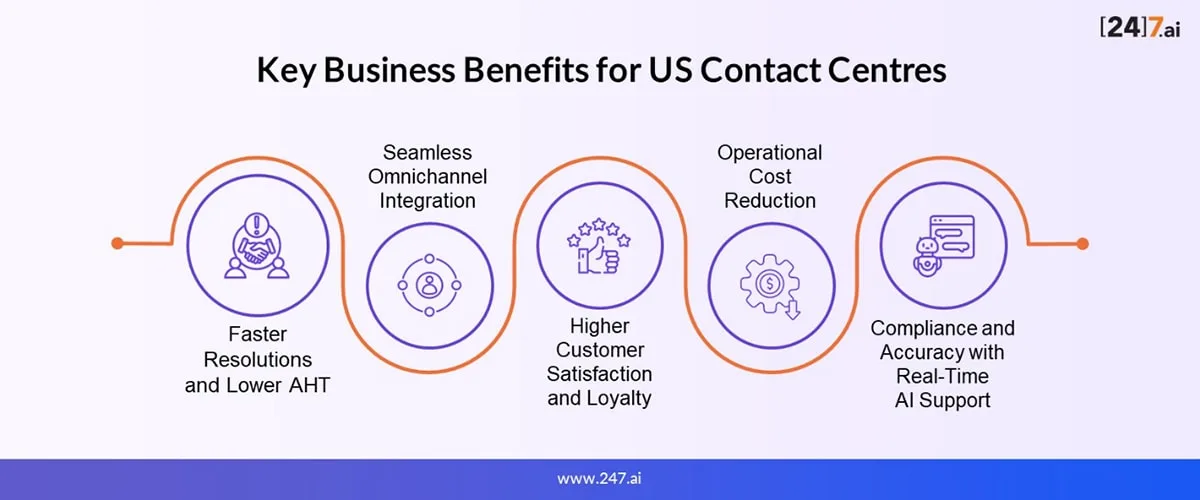Table of contents
- Introduction: Why Contact Centres Are at an Inflection Point
- From Automation to Agency: What Makes Agentic AI Different
- Redefining Customer Care Outcomes with Agentic AI
- Transforming the Agent Experience: Humans + AI in Harmony
- Key Business Benefits for US Contact Centres
- Case-in-Point: Lessons from 7.ai’s CX Leadership
- Roadmap to Scaling Agentic AI in Your Contact Centre
- Conclusion
- FAQs
Why Contact Centres are at an Inflection Point
Across the United States, contact centres are facing a pivotal moment. Customer expectations are higher than ever before. Customers want immediate, personalized answers, no matter how they connect – phone, chat, social, email, etc. At the same time, organizations are dealing with increased call volume, staffing shortages, and cost pressures eroding margins. The long-standing model of relying solely on traditional Contact Centre as a Service (CCaaS) platforms, which were designed primarily to improve efficiency, is no longer sufficient.
The industry is evolving from automation to intelligence. And now, as Agentic AI comes to market, US contact centres can move from scripted workflows, into a much more revolutionary era of AI acting with context, purpose, and autonomy. This is not simply an enabling step toward incremental performance improvement, rather it is a complete transformation of how customer service can be achieved at scale.
From Automation to Agency: What Makes Agentic AI Different
For more than a decade, automation in customer service has been synonymous with static systems. Remember all those IVR menus that leave you trapped in an infinite loop or even chatbots that may respond to a limited number of predefined questions? These technical systems reduced call volumes but only left the consumer frustrated and the agent dealing with more complicated customer situations that an automated system simply could not handle.
Agentic AI is a fundamentally different way of automation. It is a step away from compliance through rules and toward agency empowered by an AI system. In practice, this means AI systems that are:
- Reason independently about customer intent, even when the query falls outside predefined flows.
- Adapt dynamically to shifting conversations, ensuring interactions feel natural rather than rigid.
- Continuously learn from historical data and real-time interactions, improving outcomes over time.
This distinction between automation and agency is not trivial. While traditional automation removes friction from routine tasks, Agentic AI elevates the quality of engagement itself, bridging the gap between machine responses and human-caliber decision-making.

Redefining Customer Care Outcomes with Agentic AI
The most immediate benefit of Agentic AI is its ability to remove the disjointed experiences that clients typically have. In traditional systems, intent can be lost during menus, transfers, and authentication. Agentic AI circumvents these issues by serving as a partner that can account for context.
For example, when a customer contacts a call centre about a billing issue, Agentic AI can pull previous interactions, examine their payment history, and quickly provide a suitable resolution. If the issue needs to escalate, the AI hands it off with full context; no reason for the agent to start at zero.
This leads to:
This leads to:
- Shorter resolution times.
- Fewer handoffs between departments.
- Interactions that feel personalized and human-like.
The end result is not just efficiency, but improved customer trust and loyalty, as individuals feel heard and understood.

Transforming the Agent Experience: Humans + AI in Harmony
One of the most neglected areas of Agentic AI’s cost-benefit analysis is its direct influence on the human workforce. Many agents experience significant levels of burnout as a result of the cognitive load associated with managing multiple screens, processing complex queries under tight timelines, and dealing with irate customers. High agent turnover is a costly issue for US-based contact centres.
Agentic AI addresses this challenge by acting as an AI co-pilot. It:
- Provides real-time recommendations and next-best actions during live calls.
- Surfaces relevant customer data and insights without requiring manual searches.
- Automates repetitive tasks like form-filling, compliance verification, and after-call summaries.
This augmentation lessens cognitive load, improves onboarding time for new employees, and allows agents to concentrate on empathy and complex problem-solving. Agents feel better supported, less stressed, and more empowered to provide high-quality service. Organizations receive the benefit of greater retention and improved engagement in the workforce.

Key Business Benefits for US Contact Centres
1. Faster Resolutions and Lower AHT
By offering proactive guidance and eliminating manual lookups, Agentic AI significantly reduces Average Handle Time (AHT). This creates capacity for centres to handle higher call volumes without proportionally increasing headcount.
2. Seamless Omnichannel Integration
Customers today rarely stick to a single channel. They may start on live chat, switch to voice, and follow up via email. With Agentic AI maintaining context across every interaction, customers never need to repeat themselves. This consistency builds trust and improves efficiency.
3. Higher Customer Satisfaction and Loyalty
Personalized experiences directly correlate with loyalty. Studies indicate that tailored interactions can increase retention rates by double digits. Agentic AI ensures that personalization happens at scale, helping organizations protect revenue while differentiating on service.
4. Operational Cost Reduction
Contact centres spend heavily on handling repeat calls and unnecessary transfers. Smarter intent recognition and routing powered by Agentic AI reduce these costs, delivering measurable savings while maintaining or improving service quality.
5. Compliance and Accuracy with Real-Time AI Support
In heavily regulated industries such as healthcare, banking, and insurance, compliance is non-negotiable. Agentic AI supports agents by monitoring conversations, flagging potential compliance risks, and ensuring data accuracy in real time. This minimizes regulatory exposure and strengthens customer trust.
Case-in-Point: Lessons from [24]7.ai’s CX Leadership
One of the pioneers in this field, [24]7.ai, has demonstrated how Agentic AI can elevate customer experience in real-world environments. By embedding AI into every stage of the interaction lifecycle, [24]7.ai has helped enterprises achieve measurable outcomes such as:
- Reduced AHT through AI-guided agent assistance.
- Higher first-contact resolution rates by minimizing unnecessary escalations.
- Improved compliance monitoring, ensuring adherence without slowing down service.
These results underscore that Agentic AI is not aspirational. It is already proving its value across industries where customer experience is a strategic differentiator.
Roadmap to Scaling Agentic AI in Your Contact Centre
For leaders considering adoption, the key is to avoid a ‘big bang’ approach. Instead, a phased roadmap ensures scalability and measurable ROI.
- Start small with agent-assist pilots. Use AI to guide agents during live interactions.
- Expand to customer-facing workflows by enabling autonomous problem resolution for routine issues.
- Layer predictive analytics to anticipate customer needs and optimize workforce scheduling.
- Integrate enterprise-wide, connecting AI insights to workforce management, CRM, and back-office systems for holistic efficiency.
This step-by-step model ensures organizations can build trust, measure impact, and scale with confidence.
Conclusion
Agentic AI represents more than an incremental upgrade. It is a fundamental evolution that transforms US contact centres from reactive service hubs into proactive experience engines. Customers benefit from faster, more personalized resolutions. Agents gain a supportive co-pilot that reduces stress and increases job satisfaction. Businesses achieve measurable gains in efficiency, cost savings, and customer loyalty.
With success stories from innovators like [24]7.ai already validating the model, the question is no longer whether Agentic AI will reshape the industry, but how quickly organizations will embrace it.
The future of customer care is here. Those who adopt Agentic AI early will set the standard for intelligent, human-centric service in the years ahead.
Frequently Asked Questions
Traditional chatbots rely on predefined scripts. Agentic AI reasons, adapts, and learns, enabling natural, contextual conversations at scale.
No. Its purpose is to augment human performance by handling routine tasks and providing real-time support, allowing agents to focus on empathy and complex resolutions.
Organizations adopting Agentic AI report lower handle times, improved first-contact resolution, reduced costs, stronger compliance, and higher customer satisfaction scores.
Start with agent-assist pilots, expand to customer-facing workflows, and gradually integrate AI across the enterprise for maximum impact.



